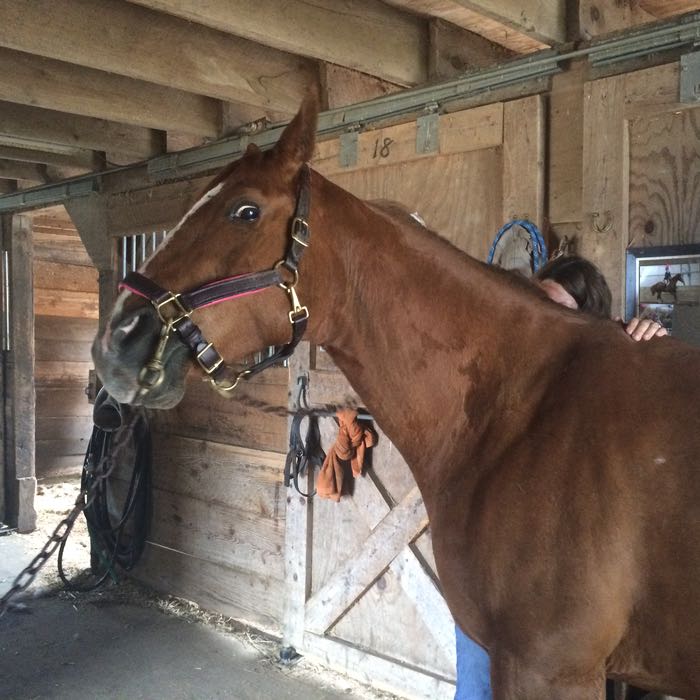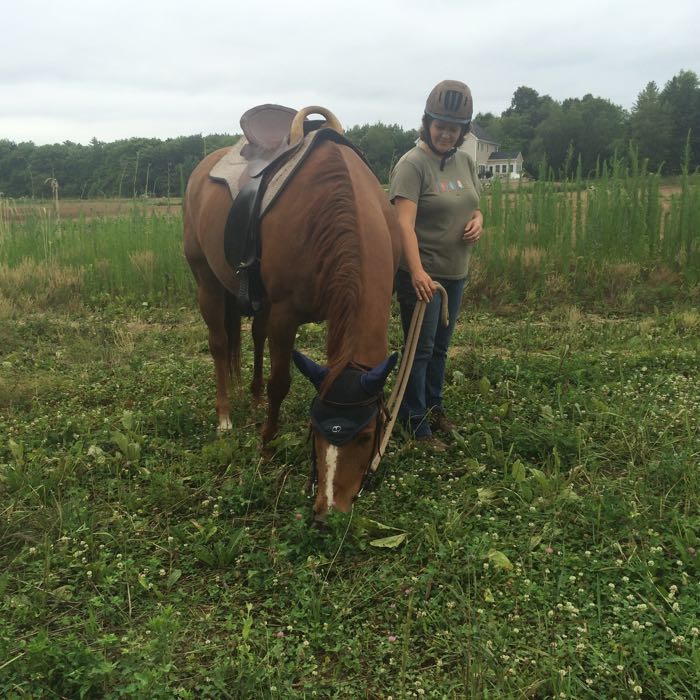Getting a horse to go where you want is not about respect. It’s not about dominance. It’s not about the horse fearing the rider more than fearing what’s ahead of them. It’s about clarity and trust. You build this relationship through training.
Lisa asked me to help her with her Quarter Horse mare, Bailey. This is Lisa’s first horse. Lisa is an adult novice rider. Bailey is a personable, smart and sane little horse who has trail and barrel racing experience. Lisa has had Bailey for a few years. She would like to ride Bailey down the path, past the fields and into the woods. It’s what she imagined when getting a horse – relaxed trail rides with her buddy. But Bailey doesn’t like to go too far away from the barn. There are deer and scary patches of shade, and once in awhile something terrifying like an irrigation sprinkler goes off. Besides, the trail is away from her horse friends and the known safety of her barn. When Lisa rides Bailey just around the bend and past the last paddock, Bailey spooks and sometimes tries to bolt. Lisa has come off.
Other riders can get Bailey to go. Other riders with more experience and stronger legs can get Bailey into the woods. But, that’s not Lisa, and it didn’t make Bailey any more confident about being ridden away from the barn. I arrived with another approach.
The first thing that I observed was that Bailey didn’t trust me.

No doubt, in her mind, I was yet another one of those people who was going to force her to do something out of her comfort zone.
We started with an issue that Bailey and Lisa have and that is prevalent at every barn – as the horse is led out of the barn, she sees grass and dives for it. Kept mostly on dirt, and fed dry hay, the horse is desperate to eat something green and growing. But the owner, justifiably, doesn’t want to be dragged all over the lawn. She has another agenda and yanks her horse’s head up. The horse jerks it back down. A horse’s head and neck can weigh as much as her person, so in order to win this fight, a chain over the nose is resorted to. This dynamic isn’t fun for anyone.
When coming up with a training solution I look at the moment of conflict, then identify what happened before that – the antecedent. Then I look before that. I want to start from the good place.
This sort of situation starts well before you get to the grass. Let’s say your horse is being groomed in the cross-ties. You’re walking all around her and maybe also chatting with other people in the barn. Then it’s time to lead her out to her paddock, so you unclip the ties and clip on the lead rope and head down the aisle. But your horse had just been a good girl by standing still so she doesn’t budge. You jerk on the rope, annoyed that she’s not moving. C’mon! That’s conflict.
Here’s a better alternative: when you attach that lead rope, focus on your horse. Let her know what’s next. Give her a chance to pay attention to you (maybe she was enjoying that grooming so much that she’s gone into a sleepy mode.) Give her a cue. Say Let’s go! in a cheerful voice. Stride out with clear body language. Pet her on the neck and tell her she’s brilliant when she follows. Maybe give her a small piece of carrot as she walks calmly next to you. Now you’re tuned into each other. Do this consistently and you will have taught your horse a cue for walking nicely next to you. (Let’s go has been very useful for me! There are times when I’ve taken Tonka to a new place and he’s hesitant to walk, maybe there’s unfamiliar pebble footing, and that the positive association with let’s go gives him confidence.)
The world outside of the barn is full of distractions, both for you and your horse. Stay tuned in. Ultimately, you want to be able to walk your horse on and past grass without her diving for it. You want to be able to stop your horse on grass and have her wait until you give the cue to graze. You’ll be able to get that! However, at first that’s too much to ask. To begin the training, when you get out to the grassy place immediately give her permission to graze. I say the cue word graze! Give her what she wants before she has to resort to yanking. Let her eat for a minute. Next, we need to teach the opposite of the graze cue. That’s a head up! You need something very special to the horse, more special than grass, to reward her for leaving that banquet. For Bailey, that treat is a peppermint. She knows the sound of a crinkling peppermint wrapper which makes it very useful for this training. I had Lisa say head up! (always in a cheerful voice) and do something to encourage Bailey to stop tearing at the grass. You can slip a foot, gently, under the nose (not kicking!) or pull on the rope (just a tad.) As soon as she moves her head up, even an inch, say good girl! and offer the peppermint. When Bailey hears that wrapper she snaps her head right up. Hand over the reward at waist height. Now her head is where you want it. Say let’s go and take a couple of steps. Say good girl! Stop, and before your horse dives for the grass, give her permission. Graze! Repeat this about five times, then take a break and do something else. If you can, do this exercise every time you’re near grass, or at least plan on a session each time you visit the barn. Soon, your horse will be calm when she sees grass because she knows that she will be given access to it, and she’ll be cooperative when asked to lift her head up (no tug needed.) Gradually extend the duration of the time walking with her head up and paying attention to you.
Be very generous with your rewards. Walking away from grass is very, very hard for a horse, especially one who might have an empty belly because they have set meal times (instead of what nature intended which is forage 24/7.) After you consistently get the head up behavior you can alternate peppermints with lower value treats, or something else that’s rewarding, like time in a paddock with a friend. Or, you might lead your horse to a better patch of grass. This is what best horse friends do. Sometimes, you can simply say head up and walk back to the barn.
Lisa has implemented this plan. Bailey is paying more attention to Lisa, and Lisa to her horse. Antecedents and consequences are consistent and valuable to both. Lisa can walk anywhere outside of the stable without dragging her horse or being dragged. They’re both a lot happier.

Lisa has a clear let’s go cue, and Bailey knows that when she does go, that something good will happen. In my next post I’ll show how that translates to riding down the trail.


Great blog, Bailey is certainly giving you the evil eye. Jess will love to read this one…:)
??? Is You Tube the only way we can watch the cams now, I hope not 🙁
HenCam accessibility can depend on your computer and how it’s configured. One of your young, tech-savvy relatives might be able to help.
Actually, there is a problem with streaming right now on HenCam. We are trying to come up with a solution and appreciate your patience.
— Mr. IT Guy
Great post, Terry. And as usual, a common sense approach to addressing the issue. I love training advice that just “makes sense”. No drama. no battles to “win”, no show downs. Just a simple “oh, that’ll work”. Completely off topic, I am fascinated by Bailey’s saddle. What’s that about? Educate me!
That saddle was a custom one in progress of being fitted, but it turned out that the tree itself wasn’t right. She now has a super-comfy, normal looking saddle that fits Bailey nicely.